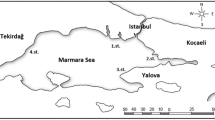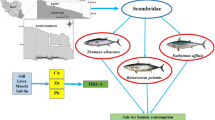Abstract
Elements are the shared result of the erosion of rocks in the catchment area and human activities. Nutritional habits, ecological needs, heavy metal concentrations in water and sediment, duration of fishing in the aquatic environment, fishing season, and physicochemical properties of water (salinity, pH, hardness, and temperature) are among the effective factors in the accumulation of heavy metals in various fish organs. In this study, 150 specimens of Rutilus kutum were collected from the southern shores of the Caspian Sea including Astara, Anzali, and Kiashahr in Guilan Province, Farahabad in Mazandaran Province, and Bandar Torkaman in Golestan Province from December 2018 through October 2019. It is possible to predict the metal concentrations using the variables such as fish tissue, sampling region, and season. Akaike information criterion (AIC) was used to select the best regression model. We used fish muscle tissue and Anzali sampling site which were considered reference variables in the regression model. For some elements, a better model is obtained by considering all variables (AIC criterion is its lowest value). The best model obtained for Cu, Mn, and Si was only with region (as a variable). The best model obtained for Sn and Sr only concerns the region and tissue variables. The best model obtained for Sb only related to tissue variable. Using these models, environmental monitoring becomes easier and cheaper. We suggest further studies to be carried out in the shortest possible time along with the least laboratory cost.



Similar content being viewed by others
Data Availability
All data in this article will be available upon request.
References
Alipour H, Banagar GR (2018) Health risk assessment of selected heavy metals in some edible fishes from Gorgan Bay, Iran. Iran J Fish Sci 17(1):21–34. https://doi.org/10.22092/ijfs.2018.115582
Bibak M, Sattari M, Agharokh A, Tahmasebi S, Imanpour NJ (2018) Assessing some heavy metals pollutions in sediments of the northern Persian Gulf (Bushehr province). Environ Health Eng Manag 5(3):175–179. https://doi.org/10.15171/ehem.2018.24
Bibak M, Sattari M, Tahmasebi S, Agharokh A, Imanpour Namin J (2020) Marine macro algae as a bio-indicators of heavy metal pollution in the marine environments, Persian Gulf. Indian J Mar Sci 49(3):357–363
Bibak M, Sattari M, Tahmasebi S, Kafaei R, Sorial GA, Ramavandi, B. (2020) Trace and major elements concentration in fish and associated sediment–seawater, northern shores of the Persian Gulf. Biol Trace Elem Res. https://doi.org/10.1007/s12011-020-02370-x
Capillo G, Silvestro S, Sanfilippo M, Fiorino E, Giangrosso G, Ferrantelli V (2018) Assessment of electrolytes and metals profile of the Faro Lake (Capo Peloro Lagoon, Sicily, Italy) and its impact on Mytilus galloprovincialis. Chem Biodivers 15(5):e1800044. https://doi.org/10.1002/cbdv.201800044
Eslami S, Hajizadeh Moghaddam A, Jafari N, Nabavi SF, Nabavi SM, Ebrahimzadeh MA (2011) Trace element level in different tissues of Rutilus frisii kutum collected from Tajan River, Iran. Biol Trace Elem Res 143(2):965–973. https://doi.org/10.1007/s12011-010-8885-9
FAO, WHO (2015) General standard for contaminants and toxins in food and feed (Codex Stan 193-1995)
FAO, WHO (1999) Summary of evaluations performed by the Joint FAO/WHO Expert Committee on Food Additives (JECFA 1956-2003). International Life Sciences Institute (ILSI Press), Geneva
Fazio F, Piccione G, Tribulato K, Ferrantelli V, Giangrosso G, Arfuso F (2014) Bioaccumulation of heavy metals in blood and tissue of striped mullet in two Italian lakes. J Aquat Anim Health 26(4):278–284. https://doi.org/10.1080/08997659.2014.938872
Forouhar Vajargah M, Mohamadi Yalsuyi A, Sattari M, Hedayati A (2018) Acute toxicity effect of glyphosate on survival rate of common carp, Cyprinus carpio. Environ Health Eng Manag 5(2):61–66. https://doi.org/10.15171/ehem.2018.09
Forouhar Vajargah M, Sattari M, Imanpour Namin J, Bibak M (2020) Length-weight, length-length relationships and condition factor of Rutilus kutum (Actinopterygii: Cyprinidae) from the southern Caspian Sea, Iran. J Anim Divers 2(2):56–61. https://doi.org/10.29252/JAD.2020.2.2.6
Janadeleh H, Kardani M (2016) Heavy metals concentrations and human health risk assessment for three common species of fish from Karkheh River, Iran. Iran J Toxicol 10(6):31–37. https://doi.org/10.29252/arakmu.10.6.31
Khanipour AA, Ahmadi M, Seifzadeh M (2018) Study on bioaccumulation of heavy metals (cadmium, nickel, zinc and lead) in the muscle of wels catfish (Silurus glanis) in the Anzali wetland. Iran J Fish Sci 17(1):244–250. https://doi.org/10.22092/ijfs.2018.118782
Kilinc BK, Malkoc S, SavasKoparal A, Yazici B (2017) Using multivariate adaptive regression splines to estimate pollution in soil. J Adv Appl 4(2):10–16. https://doi.org/10.21833/ijaas.2017.02.002
Martins A, Mata TM, Gallios GP, Václavíková M, Stefusova K (2009) Modeling and simulation of heavy metals removal from drinking water by magnetic zeolite. In: Václavíková M, Vitale K, Gallios GP, Ivaničová L (eds) Water treatment technologies for the removal of high-toxicity pollutants. NATO Science for Peace and Security Series C: Environmental Security. Springer, Dordrecht. https://doi.org/10.1007/978-90-481-3497-7_6
Mirzajani AR, Hamidian AH, Karami M (2016) Metal bioaccumulation in representative organisms from different trophic levels of the Caspian Sea. Iran J Fish Sci 15(3):1027–1043
Monsefrad F, Imanpour Namin J, Heidary S (2012) Concentration of heavy and toxic metals Cu, Zn, Cd, Pb and Hg in liver and muscles of Rutilus frisii kutum during spawning season with respect to growth parameters. Iran J Fish Sci 11(4):825–839
Mustapha A, Zaharin AA (2012) Multivariate statistical analysis and environmental modeling of heavy metals pollution by industries. Pol J Environ Stud 21(5):1359–1367
Pagano M, Porcino C, Briglia M, Fiorino E, Vazzana M, Silvestro S (2017) The influence of exposure of cadmium chloride and zinc chloride on haemolymph and digestive gland cells from Mytilus galloprovincialis. Int J Environ Res 11(2):207–216. https://doi.org/10.1007/s41742-017-0020-8
Pintilie S, Brânză L, Beţianu C, Vasile Pavel L, Ungureanu F, Gavrilescu M (2007) Modelling and simulation of heavy metals transport in water and sediments. Environ Eng Manag J 6(2):153–161. https://doi.org/10.30638/eemj.2007.021
Rosado JL, López P, Kordas K, García-Vargas G, Ronquillo D, Alatorre J et al (2006) Iron and/or zinc supplementation did not reduce blood lead concentrations in children: results of a randomized placebo controlled trial. J Nutr 136(9):2378–2383
Sattari M, Imanpour Namin J, Bibak M, Forouhar Vajargah M, Bakhshalizadeh S, Faggio C (2019) Determination of trace element accumulation in gonads of Rutilus kutum (Kamensky, 1901) from the South Caspian Sea trace element contaminations in Gonads. Proc Natl Acad Sci India Sect B Biol Sci 90:777–784. https://doi.org/10.1007/s40011-019-01150-5
Sattari M, Imanpour Namin J, Bibak M, Forouhar Vajargah M, Hedayati AA, Khosravi A (2018) Morphological comparison of western and eastern populations of Caspian kutum, Rutilus kutum (Kamensky, 1901)(Cyprinidae) in the southern Caspian Sea. Int J Aquat Biol 6(4):242–247. https://doi.org/10.22034/ijab.v6i4.529
Sattari M, Bibak M, Forouhar Vajargah M. (2020) Evaluation of trace elements contaminations in muscles of Rutilus kutum (Pisces: Cyprinidae) from the Southern shores of the Caspian Sea. Environ Health Eng Manag 7(2). https://doi.org/10.34172/EHEM.2020.xx
Stancheva L, Makedonski K, Peycheva K (2014) Determination of heavy metal concentrations of most consumed fish species from Bulgarian Black Sea coast. Bulg Chem Commun 46(1):195–203
Taghavi Jelodar H, Fazli H, Salman Mahiny A (2016) Short communication: study on heavy metals (chromium, cadmium, cobalt and lead) concentration in three pelagic species of Kilka (Genus Clupeonella) in the southern Caspian Sea. Iran J Fish Sci 15(1):567–574
United States Environmental Protection Agency (EPA) (2015) Regional screening level (RSL) summary table. EPA, USA
Valová Z, Jurajda P, Janác M, Bernardová I, Hudcová H (2010) Spatiotemporal trends of heavy metal concentrations in fish of the River Morava (Danube basin). J Environ Sci Health A Tox Hazard Subst Environ Eng 45(14):1892–1899. https://doi.org/10.1080/10934529.2010.520605
World Health Organization (2010) Exposure to cadmium: a major public health concern. WHO, Geneva
Yari AR, Siboni MS, Hashemi S, Alizadeh M (2013) Removal of heavy metals from aqueous solutions by natural adsorbents (a review). Arch Hyg Sci 2(3):114–124
Yalsuyi AM, Vajargah MF (2017) Acute toxicity of silver nanoparticles in roach (Rutilus rutilus) and goldfish (Carassius auratus). J Environ Treat Techniques 5(1):1–4
Author information
Authors and Affiliations
Contributions
Mohammad Forouhar Vajargah: investigation, methodology, and validation; Masoud Sattari: Supervision and conceptualization; Javid Imanpour Namin: visualization and software; Mehdi Bibak: writing and data analysis
Corresponding author
Ethics declarations
Ethical Approval
The study protocol and ethics of this work have been approved by the Ethical Committee of the University of Guilan.
Consent to Participate
No human or animal specimens were used in this work.
Consent to Publish
All the authors agreed to publish the data in this journal.
Conflict of Interest
The authors declare no conflict of interest.
Additional information
Publisher’s Note
Springer Nature remains neutral with regard to jurisdictional claims in published maps and institutional affiliations.
Rights and permissions
About this article
Cite this article
Forouhar Vajargah, M., Sattari, M., Imanpour Namin, J. et al. Predicting the Trace Element Levels in Caspian Kutum (Rutilus kutum) from South of the Caspian Sea Based on Locality, Season and Fish Tissue. Biol Trace Elem Res 200, 354–363 (2022). https://doi.org/10.1007/s12011-021-02622-4
Received:
Accepted:
Published:
Issue Date:
DOI: https://doi.org/10.1007/s12011-021-02622-4




